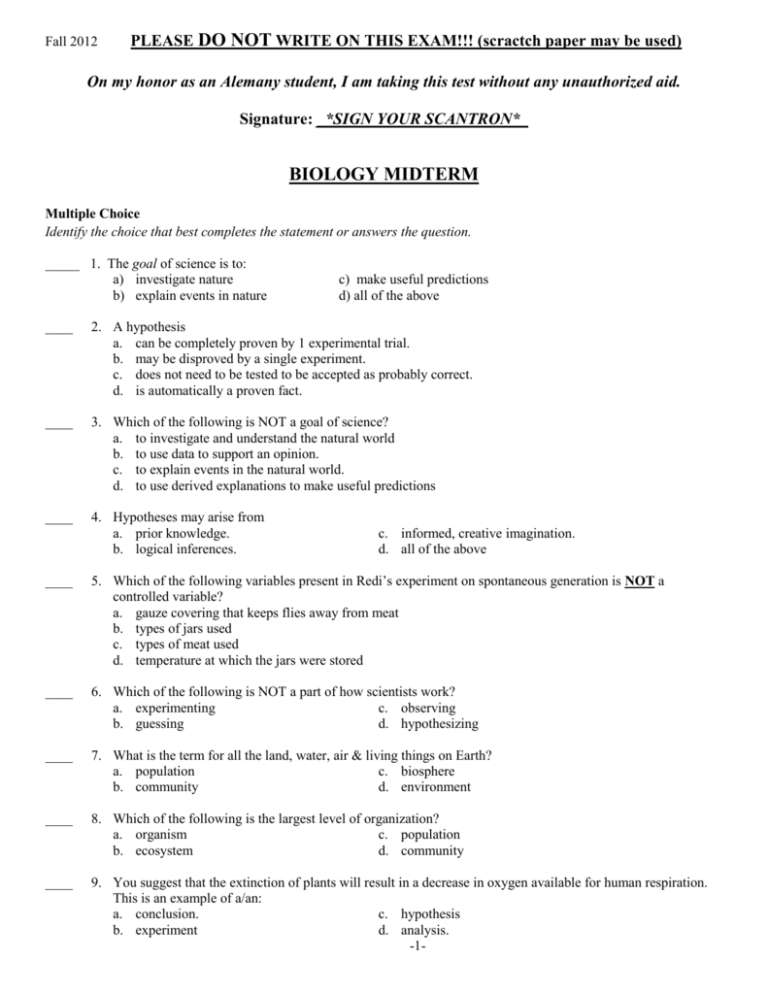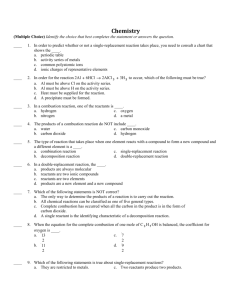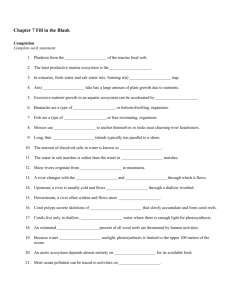PTS: 1 DIF: B REF: p. 21 OBJ: 1.3.2
advertisement

Fall 2012 PLEASE DO NOT WRITE ON THIS EXAM!!! (scractch paper may be used) On my honor as an Alemany student, I am taking this test without any unauthorized aid. Signature: _*SIGN YOUR SCANTRON*_ BIOLOGY MIDTERM Multiple Choice Identify the choice that best completes the statement or answers the question. _____ 1. The goal of science is to: a) investigate nature b) explain events in nature c) make useful predictions d) all of the above ____ 2. A hypothesis a. can be completely proven by 1 experimental trial. b. may be disproved by a single experiment. c. does not need to be tested to be accepted as probably correct. d. is automatically a proven fact. ____ 3. Which of the following is NOT a goal of science? a. to investigate and understand the natural world b. to use data to support an opinion. c. to explain events in the natural world. d. to use derived explanations to make useful predictions ____ 4. Hypotheses may arise from a. prior knowledge. b. logical inferences. c. informed, creative imagination. d. all of the above ____ 5. Which of the following variables present in Redi’s experiment on spontaneous generation is NOT a controlled variable? a. gauze covering that keeps flies away from meat b. types of jars used c. types of meat used d. temperature at which the jars were stored ____ 6. Which of the following is NOT a part of how scientists work? a. experimenting c. observing b. guessing d. hypothesizing ____ 7. What is the term for all the land, water, air & living things on Earth? a. population c. biosphere b. community d. environment ____ 8. Which of the following is the largest level of organization? a. organism c. population b. ecosystem d. community ____ 9. You suggest that the extinction of plants will result in a decrease in oxygen available for human respiration. This is an example of a/an: a. conclusion. c. hypothesis b. experiment d. analysis. -1- ____ 10. Science usually begins with a. testing a hypothesis. b. creating experiments. c. drawing conclusions. d. making observations. ____ 11. Which of the following terms includes all the others? a. paleontologist c. zoologist b. botanist d. biologist ____ 12. Safety procedures are important when working a. in a laboratory. c. with animals. b. in the field. d. all of the above ____ 13. Which of the following is NOT a characteristic of all living things? a. growth and development c. ability to move b. made of one of more cells d. ability to reproduce ____ 14. Biology is the study of a. only the land, water, and air on Earth. b. the living world. c. animals and plants only. d. the environment. ____ 15. The process by which organisms keep their internal conditions fairly constant is called a. metabolism c. evolution b. homeostasis. d. photosynthesis. ____ 16. A controlled experiment allows the scientist to isolate and test a. a conclusion. c. several variables. b. a mass of information. d. a single variable. ____ 17. What is the term for a group of organisms of one type living in the same place? a. biosphere c. population b. ecosystem d. environment ____ 18. When enough experimental data support a hypothesis, a hypothesis may become a(an) a. theory c. inference. b. fact d. conclusion. ____ 19. A hypothesis a. can be completely proven by 1 experimental trial. b. may be disproved by a single experiment. c. does not need to be tested to be accepted as probably correct. d. is automatically a proven fact. ____ 20. In science, a hypothesis is useful only if a. it is proven correct. b. it can be proven incorrect. c. the explanation is already known. d. it is testable _____ 21. The variable/s of change that may be observed in response to the one changed variable. a. manipulated variable c. responding variable b. controlled variable d. unchanged variable _____ 22. The type of variable/s that are the same throughout a controlled experiment. a. manipulated variable c. responding variable b. controlled variable d. unchanged variable _____ 23. The type of variable/s that are deliberately changed in a controlled experiment. a. manipulated variable c. responding variable b. controlled variable d. unchanged variable -2- _____ 24. What is the correct order of steps to The Scientific Method? a) inferences, observations, experiment, collect & analyze data, conclusion b) observations, hypothesis, inferences, experiment, conclusion c) observations, hypothesis, experiment, collect & analyze data, conclusion d) observations, collect & analyze data, hypothesis, experiment, conclusion _____ 25. “There are 7 birds at the bird feeder.” This is an example of what kind of observation? a) numerical c) quantitative b) qualitative d) visual _____ 26. “The birds at the feeder have brown spots.” This is an example of what kind of observation? a) numerical c) quantitative b) qualitative d) visual _____ 27. The field of Science studies only a) what can be seen c) what can be tested b) what can be proven d) what has been recorded in the past _____ 28. Besides an observation, what else is needed to make an inference? a) understanding c) a hypothesis b) prior knowledge & experience d) past studies _____ 29. How can a hypothesis be tested? a) through experiments b) by making more observations & collecting data c) field studies d) all of the above _____ 30. How many manipulated variables should a controlled experiment have? a) 1 c) 3 b) 2 d) all except for 1 _____ 31. How many controlled variables should a controlled experiment have? a) 1 c) 3 b) 2 d) all except for 1 _____ 32. Which of the following is NOT a characteristic that ALL living things exhibit? a) growing c) taking in nutrients b) breathing d) putting out wastes _____ 33. Which of the following is the smallest level at which we can study life? a) organism c) cells b) population d) atoms and molecules _____ 34. Which of the following levels studies living things and their non-living surroundings? a) population c) organism b) ecosystem d) community _____ 35. Which level of biology can we study all the living things that reside and interact in a particular area? a) population c) organism b) ecosystem d) community _____ 36. Which of the following characteristics of living things is NOT being exhibited when we sweat? a) responding to environment c) homeostasis b) maintaining internal environment d) growing and developing -3- _____ 37. Which of the following characteristics of living things is being exhibited when a caterpillar transforms into a beautiful butterfly? a) responding to environment c) homeostasis b) maintaining internal environment d) growing and developing _____ 38. A specialist who studies animals probably works in which field? a) ecology c) marine biology b) microbiology d) zoology _____ 39. Which of the following is the smallest unit of life? a) an organisms c) a cell b) a molecule d) an atom _____ 40. Which of the following is the smallest unit of matter? a) an organism c) a cell b) a molecule d) an atom _____ 41. What is the center of the atom called? a) proton c) nucleus b) neutron d) membrane _____ 42. Which of the following subatomic particles has a negative charge? a) protons c) neutrons b) electrons d) atoms _____ 43. Which of the following subatomic particles has a positive charge? a) protons c) neutrons b) electrons d) atoms _____ 44. Which of the following subatomic particles has a neutral charge? a) protons c) neutrons b) electrons d) atoms ____ 45. What information does the ATOMIC MASS tell us about an atom? a) # of protons c) # of protons + neutrons b) # of neutrons d) # of protons + neutrons + electrons ____ 46. Which of the following characteristics of living things best explains why bears hibernate during winter? a. Living things are made up of units called cells. b. Living things reproduce c. Living things respond to their environment. d. Living things are based on a universal genetic code. -4- ____ 47. Using the picture below, which is the manipulated variable(s)? a. A c. C b. B. d. D. ____ 48. Using the picture below, which is the responding variable(s)? a. A. c. C. b. B. d. D. ____ 49. Using the picture below, which is the controlled variable(s)? a. A. c. C. b. B. d. D. ____ 50. Using the picture below, which is the control “group”? a. A. c. C. b. B. d. D. -5- BIOLOGY MIDTERM EXAM (A) Answer Section MULTIPLE CHOICE 1. ANS: OBJ: 2. ANS: OBJ: 3. ANS: OBJ: 4. ANS: OBJ: 5. ANS: OBJ: 6. ANS: OBJ: 7. ANS: OBJ: 8. ANS: OBJ: 9. ANS: OBJ: 10. ANS: OBJ: 11. ANS: OBJ: 12. ANS: OBJ: 13. ANS: OBJ: 14. ANS: OBJ: 15. ANS: OBJ: 16. ANS: OBJ: 17. ANS: OBJ: 18. ANS: OBJ: 19. ANS: OBJ: 20. ANS: OBJ: 21. ANS: OBJ: C 1.2.2 B 1.4.4 B 1.1.1 D 1.1.2 A 1.2.1 B 1.2.1 C 1.3.2 B 1.3.2 C 1.1.2 D 1.1.1 D 1.3.2 D 1.4.4 C 1.3.1 B 1.3.1 B 1.3.1 D 1.2.1 C 1.3.2 A 1.2.2 B 1.1.2 D 1.1.2 C 1.3.1 PTS: 1 DIF: B REF: p. 14 PTS: 1 DIF: A REF: p. 28 PTS: 1 DIF: A REF: p. 3 PTS: 1 DIF: B REF: p. 5 PTS: 1 DIF: E REF: p. 9 PTS: 1 DIF: B REF: p. 8 | p. 9 | p. 10 PTS: 1 DIF: E REF: p. 21 PTS: 1 DIF: E REF: p. 21 PTS: 1 DIF: E REF: p. 5 PTS: 1 DIF: B REF: p. 4 PTS: 1 DIF: A REF: p. 20 PTS: 1 DIF: B REF: p. 28 PTS: 1 DIF: A REF: p. 16 | p. 17 | p. 18 | p. 19 PTS: 1 DIF: B REF: p. 16 PTS: 1 DIF: B REF: p. 19 PTS: 1 DIF: A REF: p. 9 PTS: 1 DIF: B REF: p. 21 PTS: 1 DIF: B REF: p. 14 PTS: 1 DIF: E REF: p. 5 PTS: 1 DIF: A REF: p. 5 | p. 6 PTS: 1 DIF: E REF: p. 19 MODIFIED TRUE/FALSE 22. ANS: REF: 23. ANS: REF: 24. ANS: T p. 15 T p. 3 | p. 5 F, cells PTS: 1 DIF: E PTS: 1 DIF: A PTS: 1 DIF: B 25. ANS: F, observation REF: p. 17 OBJ: 1.3.1 PTS: 26. ANS: REF: 27. ANS: 1 T p. 3 F, wild REF: p. 4 PTS: 1 OBJ: 1.1.1 DIF: B PTS: 28. ANS: REF: 29. ANS: 1 DIF: B T p. 5 OBJ: 1.1.2 F, manipulated REF: p. 14 PTS: 1 OBJ: 1.2.1 DIF: E OBJ: 1.2.2 OBJ: 1.1.2 DIF: E OBJ: 1.1.1 PTS: 1 30. ANS: F, electrons DIF: A REF: p. 9 OBJ: 1.2.1 PTS: 31. ANS: REF: 32. ANS: 1 T p. 20 F, biosphere DIF: A REF: p. 25 PTS: 1 OBJ: 1.4.2 DIF: E PTS: 33. ANS: REF: 34. ANS: 1 T p. 28 F, sexually DIF: B REF: p. 21 PTS: 1 OBJ: 1.3.2 DIF: B REF: p. 17 OBJ: 1.3.1 PTS: 1 OBJ: 1.3.2 OBJ: 1.4.4 DIF: A









